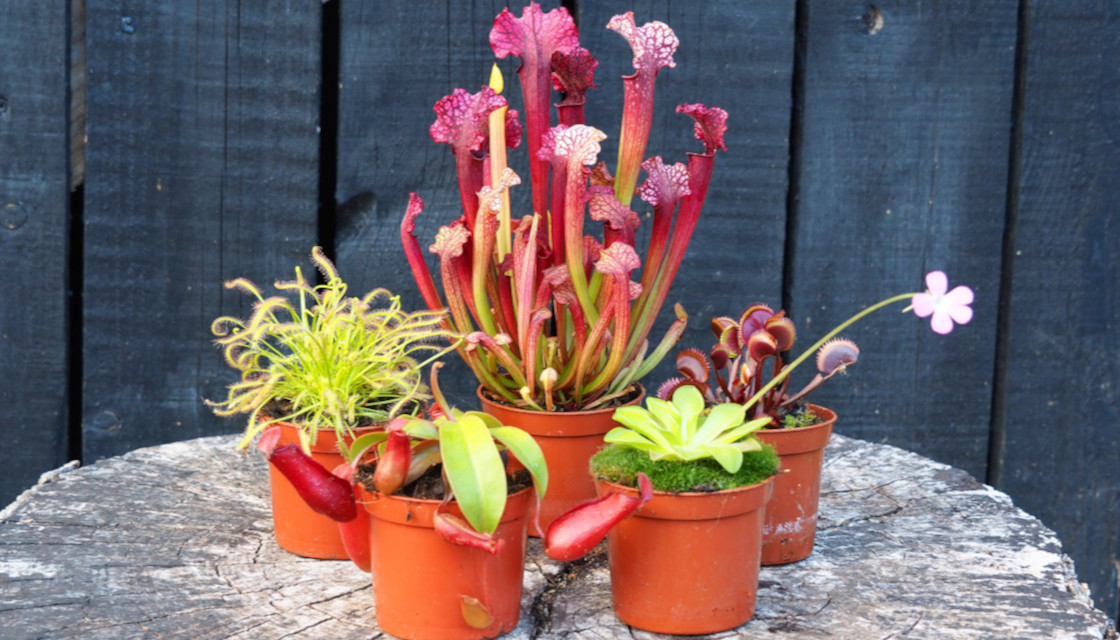Buying your first Carnivorous Plant can be a very exciting experience. These fascinating plants deserve a place in everyone’s home or garden, as carnivorous plants are impressive plants which will live for years. But how do you care for a carnivorous plant? The easiest plants to grow are Venus Flytraps, Sundews and some Trumpet Pitchers.
General Care Tips for Carnivorous Plants
On this page we have listed some useful tips to enjoy this impressive and interesting plant species for years to come. The care tips on this page are described in general terms. Do you want to know more about a specific species? Then scroll down.
Nutrition for Carnivorous Plants
In nature, the carnivorous plant lives in poor soil and due to that fact carnivorous plants started catching insects. It is best to make sure your carnivorous plants are in a place where they can catch insects themselves, like a greenhouse, conservatory or outside. If you would like to feed a Carnivorous Plant yourself, then pay attention to the frequency and never feed them real meat. Apart from feeding with insects, carnivorous plants need enough water and sunlight.
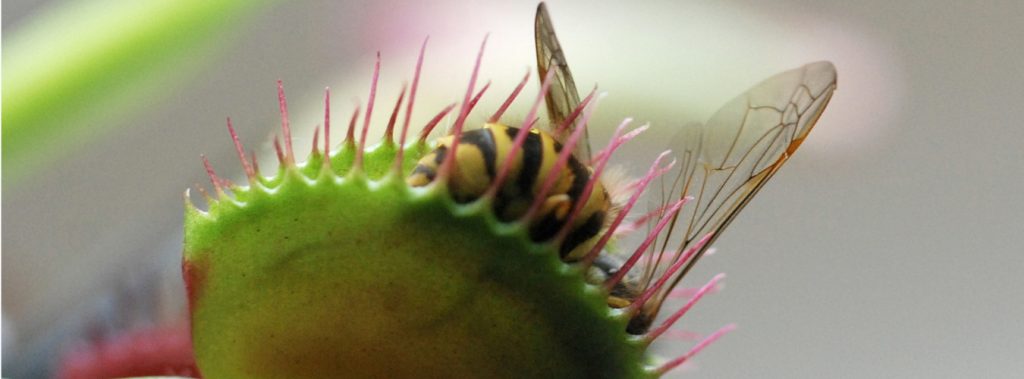
Venus Flytrap with wasp-eating sized traps.
Light
Most Carnivorous plants love a sunny spot. For some species, like Venus flytrap (Dionaea muscipula) for example, sunlight can never be too much. A Monkey Cup Plant (Nepenthes), on the contrary, is a tropical plant and does not like too much direct sunlight. Cups may burn or dry out. Butterwort (Pinguicula) also likes some indirect light in summer. Pinguicula and Nepenthes, both like to be in half shade and that is why it is best to put the plants only in direct sunlight in the morning and provide them with indirect light during the rest of the day. An east facing windowsill would be best. Since species such as Venus Flytrap and Trumpet Pitcher Plant will tolerate a mild winter, it is advisable to put these plants in a sunny windowsill or outside (in the sun).
Water
Carnivorous plants are marsh plants, and in nature live in nutrient-free soil. As a result, the plants have not evolved well enough to distinguish between ‘good’ and ‘bad’ nutrients, so the plant will absorb all substances in the water. For this reason, tap water is bad for carnivorous plants and is therefore not recommended. If in a rare occasion you only have tap water, use it, as the plant will dry out and die otherwise. Tap water contains lime and other minerals. Some people boil tap water, but this won’t decrease the amount of lime and other minerals. Mineral water is also not advisable, as this water is full of minerals. As carnivorous plants are bog plants, most species need a lot of water. The soil should be as wet as possible. Note that the amount of water varies during the season and from species to species.
Soil
Most carnivorous plants are grown in a mixture of sphagnum moss, perlite and grit. Special carnivorous plant compost contains little to no nutrients and is therefore best to use for your plants. The compost we offer is used in our nursery and specially developed for carnivorous plants.
Remove leaves
As with flowers and other plants, carnivorous plants do not always have the same traps and leaves. Even in carnivorous plants, leaves and traps die. When the traps and leaves are old, they slowly turn brown or black. Remove the leaves and traps when they are either completely black, or more than half brown. Monkey Cup plants (Nepenthes), it is best to cut off a brown cup including the leaf. Trumpet pitcher plants, it is best to cut off traps when they have turned more than half brown. Cut them down to the 10 cm from the bottom. Venus Flytrap and Sundew, are best to remove the traps when they have turned completely black. Then you can remove the traps and stems very easily. By removing the dead and brown leaves, mildew has no chance. Besides, it looks a lot more tidy and beautiful.
Winter dormancy
Some (hardy) carnivorous plants, such as the Venus flytrap (Dionaea muscipula) and the Trumpet Pitcher plant (Sarracenia) will enter a dormancy period during autumn / winter. During this rest period, it is important that the carnivorous plants do not get too much water (just enough to keep it moist) and that the carnivorous plants are in a cooler place. If you have the carnivorous plants in the garden, make sure the plants are protected from the cold during severe frosts.
Carnivorous Plants Species
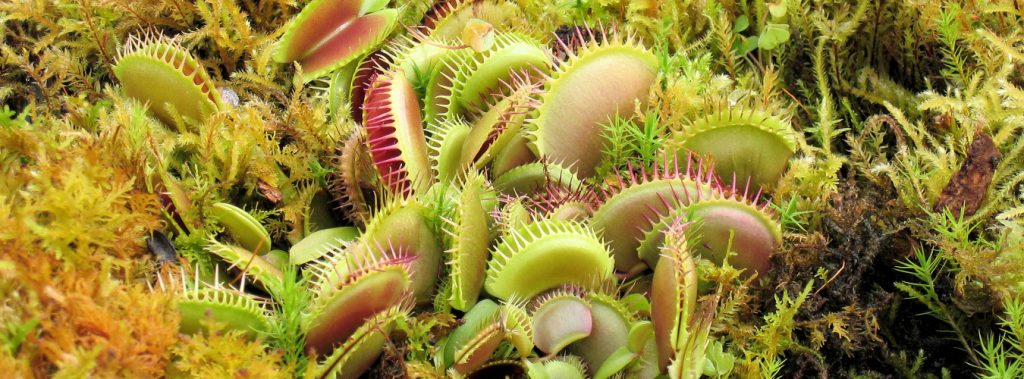
Venus Flytrap grows in live sphagnum moss.
Venus Flytrap (Dionaea muscipula)
The Venus Flytrap is native to subtropical swampy areas (North America and Canada). This means that Venus Flytrap are true outdoor plants and like a lot of water. The Venus Flytrap catches its prey using a clap trap. Care for the Venus Flytrap is fairly easy.
Habitat: The Venus Flytrap is best kept outdoors. Indoors is possible, but in the long run it is better to keep it outside. The Venus Flytrap can survive well outdoors in the Dutch climate.
Type of pot: Preferably put the Venus Flytrap in a swamp box or in a pot with holes and a saucer underneath. Never use a terracotta pot, as this pot contains all kinds of substances that the plant also absorbs. These are bad substances that can kill the plant. Preferably use a plastic, glass or glazed container or pot.
The Venus Flytrap should always have wet feet in summer. This means there should always be water in the saucer or the soil should always be wet. In summer with hot weather, you should water the plant every day. The more water, the better. In winter months, it is better to keep the plant moist, but not too wet.
Light: The Venus Flytrap needs a lot of sunlight. The more sunlight, the better. Sunlight improves the quality of the traps and makes them more colourful. This is because sunlight causes the traps to turn red due to pigment. The redder the traps are, the better they lure ‘mouthing’ insects. In fact, insects flock to these beautiful colours.
Feeding: You don’t need to feed the Venus Flytrap. Especially not if it is outside. The plant regulates its own nutrition. Never give the plant real meat! Of course, you can always help a little by feeding self-caught flies to the plant.
The mouths of the Venus Flytrap die after they close 10 times. Then the traps turn black. This is normal. It makes room again for the new traps. You can very easily remove traps that have turned black with your fingers or tweezers.
Soil: Never plant the Venus Flytrap in normal potting soil or potting soil with nutrients. Because the plant has never learned to extract nutrition from the soil, bad substances cannot be broken down. Preferably use special soil for carnivorous plants, or make your own mix of blond peat (without any nutrients, so pure peat) and perlite. A mix of 1:1 perlite and blond peat is recommended. Find our types of soil here.
Hibernation: The Venus Flytrap also hibernates. This means that the plant retreats back into the ground during the winter months. The plant will just appear dead, but this is an illusion. Underground, the Venus Flytrap prepares itself well for the growth period in spring. Read more about winter here.
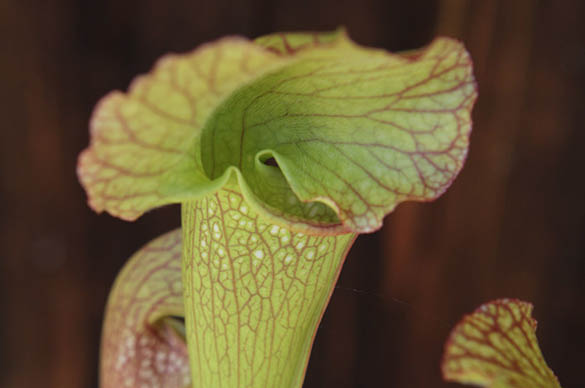
Sarracenia (Trumpet Pitcher)
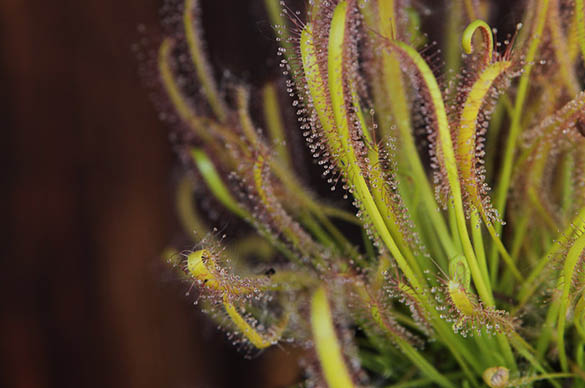
Drosera (Sundew)
Trumpet pitcher plant (Sarracenia)
Sarracenia species are found in subtropical swampy areas, such as in North America. The Sarracenia lures its prey by means of its catching cups. Caring for the Sarracenia is easy.
Sarracenias do best outdoors. Outside, they get more sunlight and can catch more insects. They can survive well outdoors in the Dutch climate. Sarracenias can also stand indoors, only the plant will not do well indoors in the long run. Outdoors is the best location for this species.
Water: Sarracenias occur in swampy areas and therefore like wet soil. Sarracenias need wet soil. The wetter, the better! Preferably only use tap water if you don’t have the option of other water. This is because the plant cannot tolerate lime and other substances in tap water. Preferably use: rainwater, osmosis water or demineralised water.
Light: Sarracenias like a lot of sunlight, the more the better. Make sure the soil never dries out. Sunlight gives the traps a nice red/purple colour and they will also grow much higher. The beautiful colours also attract more insects.
Nutrition: You don’t need to feed the Sarracenias, they take care of their own nutrition. Never give meat to the plants! Of course, you can help the plant a little by giving it your own caught flies.
Soil: Never plant the Sarracenia in ordinary potting soil. The plant cannot stand this. When planting Sarracenias, use special soil for carnivorous plants.
Traps: The traps of a Sarracenia should be thought of as leaves. Just like ‘normal’ leaves on plants, the traps will die. When the tubes are more than half brown, it is best to cut them off. This will create space again for the new traps.
Hibernation: Sarracenia also hibernates. This means that the species goes back into the ground in autumn. Most of the traps will then die off. The plant appears dead, but it is not. The plant is preparing underground again for the growth period in spring.
Sundew (Drosera)
Droseras exist in warm areas and colder areas of the world. Some species of Drosera are found native to the UK, such as D. anglica and D. rotundifolia. Droseras catch their prey by means of an adhesive trap. Caring for Droseras is quite easy.
Tropical Droseras like Drosera capensis, D. capensis alba, D. scorpioides, D. aliciae and D. madagascariensis are from warm regions, therefore, it is best to keep these species indoors. Some Drosera species such as D. anglica, D. hybrida D. filiformis and D. binata are outdoor carnivorous plants, and can be kept outdoors as well as indoors.
Water: Droseras occur in swampy areas and like wet feet. Make sure to keep the soil wet at all times. A tray of water is very useful to put the potted plants in. The soil in the pot will suck up the water from underneath. IMPORTANT: Never give drosera plants tap water, they cannot tolerate this. Preferably give rainwater, osmosis water or demineralised water to the plants.
Light: Droseras love light, therefore put the plant in a bright/sunny spot.
Sometimes the Drosera may loose its drops. This is due to low humidity or entering winter dormancy. In this case, put the Drosera in a place with higher humidity, or put a glass around the Drosera to allow the humidity to rise.
Supplementary feeding: there is no need to feed Drosera, as they regulate their own nutrition. Never give the plant meat! Of course, you can give the plant your own caught flies. In this case, preferably provide the Sundew with small flies.
Hibernation: Some Drosera species hibernate for the winter. The outdoor varieties will die back into the ground. However, tropical species do not really hibernate. These species will only grow less in winter. This is because it gets colder, the sun is less bright and there are also fewer insects in winter. In spring, the growing period starts again.
Cobra Lily (Darlingtonia californica)
Darlingtonia californica, the cobra lily, is a beautiful, unusual and intriguing carnivorous plant. With proper attention to growing conditions, this plant is really a great asset for the carnivorous plant lover. Darlingtonia californica prefers daytime temperatures between 10 and 25 degrees Celsius.
In winter, the plant will not grow and needs lower temperatures to go dormant and strengthen its roots. The roots like cool temperatures and do not like stagnant water. It is therefore wise to use a large pot and some people even put ice cubes in the water on very hot days. The water given to the cobra lily should be soft, such as rainwater or osmosis water.
The soil should be nutrient-poor and allow the water to drain easily. Although the Cobra lily is not the easiest type of carnivorous plant, it is definitely worth growing.
Monkey Cup plant (Nepenthes)
The Nepenthes is found in jungles around the world. This species likes a tropical climate, which is why it is best to keep Nepenthes indoors in the UK. The species of Nepenthes lure their prey with cup traps.
Nepenthes are divided in two groups: highland and lowland Nepenthes. That is why both species like high humidity. The difference between a highland and lowland Nepenthes is that lowland Nepenthes like similar temperatures between 20 and 35 C degrees, while highland Nepenthes likes having cooler temperatures during the night ranging between 10 to 30 C degrees.
We recommend to wet the cups and leaves of the Nepenthes every few days with a handheld sprayer. In addition, the soil of the Nepenthes should be kept wet. The Nepenthes prefers to be watered from above. A splash of water every other day is therefore sufficient. Never use tap water, as the plant cannot tolerate it. Preferably use rainwater, osmosis water or demineralised water.
Light: The Nepenthes likes direct and indirect light. In the jungles, they also get little direct light because many other plants take up sunlight. The Nepenthes does fine in a stand with indirect light, but likes direct sunlight too. In front of a window with both direct sunlight and indirect sunlight, the plant will do best. IMPORTANT: Make sure the plant is not in direct sunlight during the hot summer months. This is because it can get extremely hot in front of such a window, which can cause the cups to burn.
Aspect: An ideal spot would be to put the plant in a place where the Nepenthes has (cool) direct sunlight in the morning and indirect sunlight in the afternoon.
Feeding: Carnivorous plants don’t necessarily need supplementary feeding. But when the plants are indoors, they can be less likely to attract flies. Therefore, you could feed your plants with dried or live insects. However, never give the plants meat!
Cut the traps: Are the traps brown? Then cut them off from the leaf. Are the leaves brown? Then carefully cut these away too.
Hibernation: Nepenthes hibernates, but not like Venus flytrap (Dionaea muscipula) and Trumpet Pitcher plants (Sarracenias). The plant will not grow as fast in winter and creates few new traps. In spring, the growth period will start.
Refill cups: have you just received the Nepenthes and are the cups empty due to transport? Then refill them once to 1/3 – otherwise the plant may shed the ‘dried-out’ cups quite quickly. The Nepenthes will then fill the old and new cups itself with water and enzymes. So make sure the plant gets enough water.
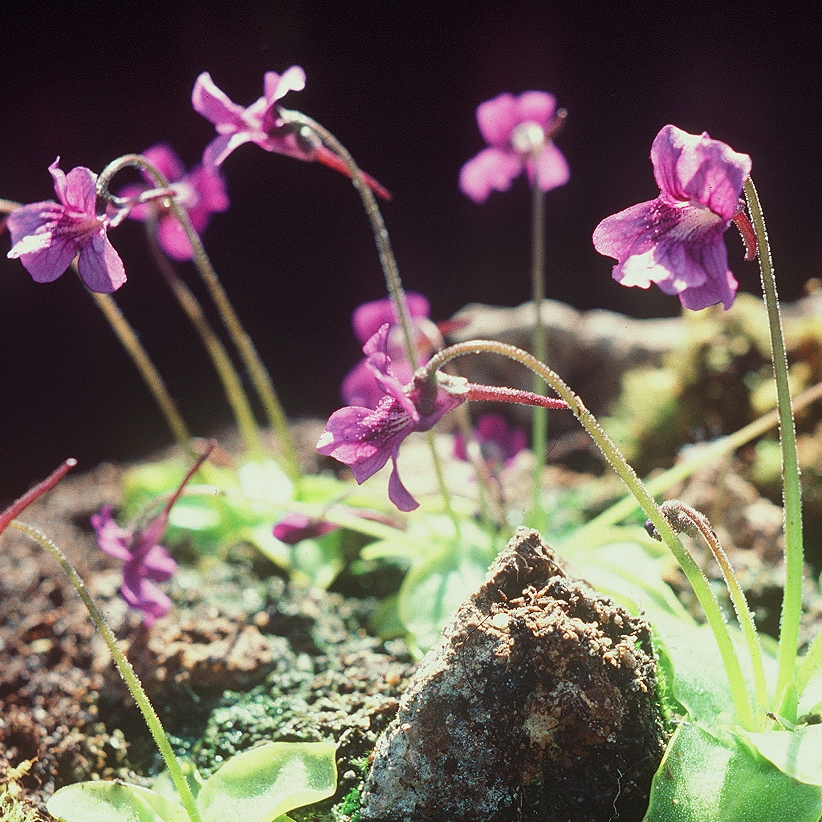
Pinguicula (Butterwort)
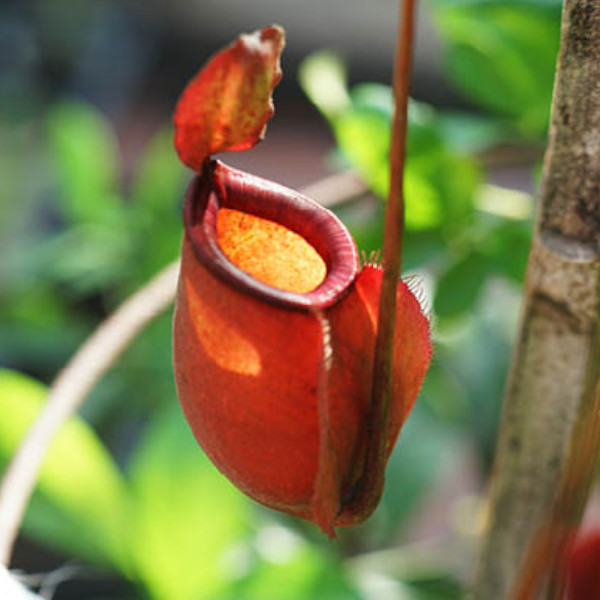
Nepenthes (Monkey Cup)
Butterwort (Pinguicula)
Pinguicula, is also known as butterwort. The Pinguicula is a carnivorous plant with sticky leaves, also reminiscent of a fat leaf. With these sticky leaves, this carnivorous plant catches its prey. The Pinguicula species can be found in North, Central and South America, but also in Europe and Asia. Pinguicula is easy to care for.
The leaves of Pinguicula have very small sticky/dew drops on them. These droplets smell very nice to insects. When an insect lands on the leaf, the insect is stuck – to which the plant owes its name ‘fat leaf’. Pinguicula is best at catching mosquitoes, fruit flies, mourning flies and other small/light insects. Large flies are too strong and can often pull away from the leaf. Small flies cannot. Besides, Pinguiculas possess beautiful, purple flowers – making this species a true ‘eye-catcher’ in the house.
There are different varieties of Pinguiculas. There are species that are hardy and those that are tropical. Hardy species we offer are Pinguicula grandiflora. Some tropical Pinguiculas we offer are Pinguicula ‘Tina’ and Pinguicula weser. Tropical Pinguiculas need to be kept indoors. In summer with warm weather, they can be placed outside, but make sure it doesn’t cool down to more than 17 C degrees.
Light: Pinguiculas like light, but not full sun. Make sure you put the plant in a spot where there is plenty of indirect light coming in. Direct light in the morning is often fine.
Water: Compared to other species, Pinguicula does not need that much water. The soil does not have to be constantly wet, as too wet soil can cause root rot in this species. So keep the soil slightly moist. A splash of water from above once or twice a week is sufficient. So don’t put the plant on a saucer with water, but water it from above. Always try to water under the leaves.
No oily leaves? This could be due to too low humidity. You can remedy this by putting transparent kitchen foil or a glass over the plant. Leave this in place for a few days. That way, the humidity can rise and the drops will return.
Utricularia (Bladderwort)
Utricularia is not a very difficult plant to care for and could be placed in a terrarium or on a windowsill. Make sure it has a bright spot. The temperature should be around 22⁰C, but should not get much higher to avoid dehydration.
This species likes a lot of moisture and should therefore be constantly under a small layer of water. Preferably use low-mineral water for this, e.g. rainwater. A mixture of fine sand, perlite and moss makes a good substrate.
Cephalotus follicularis (Albany Pitcher)
Cephalotus follicularis (Albany Pitcher) is an Australian pitcher plant. The species is found in the wild in South-West Australia in a so called meso-mediterranean climate. In this climate, summers are hot and winters are wet and quite cold. This climate is found in areas such as South Africa, Chile, California and South-West Australia.
In Australia, the Cephalotus is hardy, but not in the UK as our winters are a lot colder. In summer Cephalotus follicularis could survive outdoors, but bring it back inside when it becomes colder than 15 degrees.
The Cephalotus uses a cup trap. These cups contain a nectar with enzymes. The nectar attracts insects, and the enzymes process the insects. The rim of the cups look like ‘teeth’. These ‘teeth’ prevent insects to escape. In Australia, this species mainly catches ants.
Water: Compared to other carnivorous plant species, Cephalotus needs a lot less water. The soil is allowed to dry out slightly. Depending on the heat, water your Cephalotus follicularis once or twice a week. Leave the Cephalotus on a saucer, so you can refill the saucer with water. The Cephalotus is a rather fragile plant, so preferably use rainwater and not tap water. Never pour water into or over the cups.
Light: The Cephalotus likes light. Preferably put the Cephalotus in a sunny spot without extreme temperatures or temperature differences.
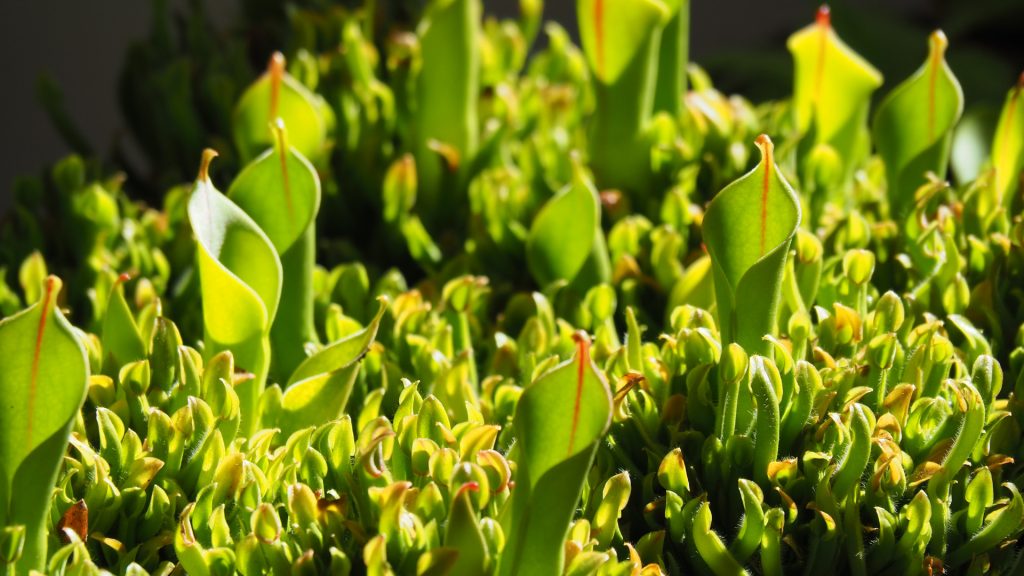
Heliamphora heterodexa x minor
Heliamphora heterodoxa x minor
Heliamphora is found exclusively on Table Mountains. Table Mountains are mountains with a flat top and a steep slope. Heliamphora’s habitat is Venezuela and South America.
Heliamphora has a kind of trumpet pitcher, but this pitcher is much harder in structure and shorter in length than Sarracenias. The trap has a rolled-up leaf that functions like a cup. Inside the cup enzymes digest the caught insects. At the top of the cup is a small tab, on this tab are nectar glands that emit a wonderful smell. With this scent, it lures its prey. Inside the trap grow small hairs which will prevent the prey from escaping.
Habitat: Heliamphora is best kept indoors, as it cannot tolerate very high or very low temperatures. It grows best in a climate between 3 degrees and 25 degrees. Outside, it is often much warmer in summer and much colder in winter. In addition, this species of carnivorous plant is not winter hardy, so it will not survive outside in winter.
Light: Heliamphora likes lots of sunlight. Therefore, place the plant in a sunny spot with plenty of direct sunlight.
Compared to its fellow carnivorous plant species, Heliamphora does not like to stand in water all the time. Make sure the soil is moist and does not dry out, but make sure it isn’t constantly soaking wet. Heliamphora heterodexa x minor prefers to be watered from above. Which enables the water to flow / seep through the soil well. Spray the tubes once or twice a week (you can even spray inside the tubes), to keep the traps humid.
Carnivorous Plant Tutorial Videos
In our tutorial videos we will provide you with clear instructions about propagating Venus Flytraps or Trumpet Pitchers, repotting Carnivorous Plants and some timelapse videos of Sundews filmed by BBC.
Carnivorous Plant Care Guides
You will receive a care guide for your specific carnivorous plant(s) with every purchase. If you would like to know more of the various carnivorous plant species before purchasing one, we also provide downloadable care guides.

